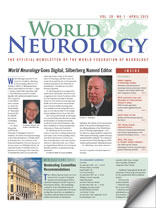The trustees of the World Federation of Neurology (WFN) recently approved a newly created Applied Research Group on Coma and Disorders of Consciousness, chaired by Steven Laureys.
Its mission, consistent with the goals and objectives of the WFN, is to improve worldwide the knowledge and care of patients with brain death, coma, locked-in syndrome and chronic disorders of consciousness following severe acquired brain damage such as vegetative state/unresponsive wakefulness and minimally conscious state. We aim to achieve this mission by improving the best care, diagnosis, prognosis, treatment, prevention and scientific understanding; by facilitating multidisciplinary research, education and public awareness in this challenging field confronting neurological, epidemiological, neuroscientific (including in the fast-growing fields of functional neuroimaging, electrophysiology, neuro-engineering and computational sciences), neuro-ethical, philosophical and legal expertise.
Coma is an acute condition of unarousable unresponsiveness in which patients never show any eye opening. Unresponsive wakefulness syndrome (previously coined vegetative state) is defined by wakefulness (i.e. eye opening) without any sign of awareness of self and the environment whereas minimally conscious patients show fluctuating signs of awareness such as visual pursuit, localization to pain or reproducible response to command but they remain unable to communicate consistently. This condition has been recently subcategorized in “minimally conscious +” for patients who present high-order behavioral responses to stimuli (with preservation of language processing ability) and “minimally conscious –” for patients who only show low-level non-reflexive responses to stimuli (e.g., visual pursuit).
Recovery of the ability to functionally communicate or to use objects adequately is necessary for the diagnosis of the emergence of a minimally conscious state. Finally, patients who show non-behavioral evidence of consciousness or communication only measurable via complimentary testing (i.e., functional MRI, positron emission tomography, EEG or evoked potentials) can be considered to be in a functional locked-in syndrome.
The presence or absence of consciousness is assessed at the patient’s bedside by searching for response to command or non-reflexive behaviors in response to stimulation. Assessing the level of consciousness of noncommunicative brain-damaged patients is therefore difficult, as consciousness is a subjective first-person experience and you necessarily need to make inferences about its presence based on the patient’s behavior. In the acute setting, the Full Outline of UnResponsiveness has been proposed as an alternative for the widely used Glasgow Coma Scale.
To disentangle vegetative/unresponsive from minimally conscious/responsive states, other scales have been validated such as the Coma Recovery Scale-Revised. Still, patients might present severe limitation from motor dysfunction (e.g., paralysis and spasticity), sensory deficit (e.g., deafness, blindness), impaired cognitive processing (e.g., aphasia, apraxia), fluctuation of vigilance and pain that can prevent voluntary responses. So even with the best clinical assessment, patients might be underestimated in terms of residual brain function and conscious awareness.
Clearly, severely brain-damaged patients and disorders of consciousness represent a major diagnostic, prognostic, therapeutic and often ethical challenge for neurology.
Indeed recent studies provide evidence for preserved awareness in some behaviorally unresponsive patients. For instance, using functional MRI or EEG, such patients may activate specific brain areas and generate appropriate brain responses when performing cognitive tasks on command (e.g. imagine to move), similar to those observed in healthy controls. These paradigms allow inferring consciousness and may even permit to communicate in some exceptional cases. However, more research and multicentric collaboration is needed to validate the accuracy of these novel technologies at the single patient level. Similarly, the clinical value of prognostic markers ranging from simple behavioral signs to sophisticated brain measures such as diffusion tensor imaging MRI requires continuing validation by large international cohort studies.
Clearly, severely brain-damaged patients and disorders of consciousness represent a major diagnostic, prognostic, therapeutic and often ethical challenge for neurology. Alot more work and collaboration is therefore needed, and the development of this new group will promote the state-of-the art knowledge at both the clinical and neuroscientific level, facilitating inter-group communications, broadening multicentric studies and amplifying the voice of all professionals and family groups working in this field.
For more comments, information or for joining this novel WFN Research Group, contact coma@ulg.ac.be.
Dr. Gosseries is neuropsychologist at the Coma Science Group (Cyclotron Research Center, University and University Hospital of Liege, Belgium) and postdoctoral researcher at FNRS (Belgian National Fund for Scientific Research). Professor Laureys is director of the Coma Science Group, clinical professor of neurology, FNRS research director and chair of the European Neurological Society Subcommittee on Coma and Disorders of Consciousness.



